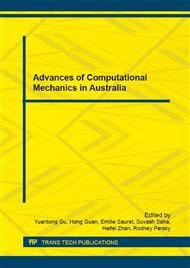[1]
J. McNamara, P Friedmann, Aeroelastic and Aerothermoelastic Analysis in Hypersonic Flow: Past, Present and Future, AIAA Journal Vol. 49 (2011) 1089-1122.
DOI: 10.2514/1.j050882
Google Scholar
[2]
R. Hallion, The Hypersonic Revolution: Case Studies in the History of Hypersonic Technology, Volume I, Air Force History and Museums Program, (1998).
DOI: 10.21236/ada441127
Google Scholar
[3]
R.A. East, G.R. Hutt, Comparison of Predictions and Experimental Data for Hypersonic Pitching Motion Stability, Journal of Spacecraft and Rockets (1998).
DOI: 10.2514/3.25975
Google Scholar
[4]
P.W. Hanson, Aerodynamic effects of some configuration variables on the aeroelastic characteristics of lifting surfaces at Mach numbers from 0. 7 to 6. 86. NASA TN D-984, (1961).
Google Scholar
[5]
R.C. Goetz, J.L. Sewall, Experimental flutter study of a wing-fuselage configuration at a Mach number of 15. 4 and comparison with theory, NASA TN D-3046, (1965).
Google Scholar
[6]
C. Spain, T.A. Zeiler, E. Bullock, and J.S. Hodge, A Flutter Investigation of All-Moveable NASP-Like Wings at Hypersonic Speeds, AIAA Journal, (1993).
DOI: 10.2514/6.1993-1315
Google Scholar
[7]
J. McNamara, P. Friedmann, Aeroelastic and Aerothermoelastic Analysis of Hypersonic Vehicles: Current Status and Future Trends, AIAA Journal (2007).
DOI: 10.2514/6.2007-2013
Google Scholar
[8]
J.D. Watts, Flight Experience with Shock Impingement and Interference Heating on the X-15-2 Research Airplane, NASA TM X-1669, (1968).
Google Scholar
[9]
A. Arman, Study of Flow over Oscillating Airfoil Models at a Mach number of 7. 0 in Helium, NASA TN D-992, (1961).
Google Scholar
[10]
D. Dolling, Fifty Years of Shock-Wave/Boundary-Layer Interaction Research: What Next? AIAA Journal 39 (2001) 1517-1531.
DOI: 10.2514/3.14896
Google Scholar
[11]
K. Yamada, Design and build of a pitching-plate test rig for shock tunnels, BE/ME thesis, University of Queensland, (2015).
Google Scholar
[12]
D.R. Buttsworth, Ludwieg Tunnel Facility with Free Piston Compression Heating for Supersonic and Hypersonic Testing, National Space Society of Australia, (2010).
Google Scholar
[13]
A. Widodo, D.R. Buttsworth, Stagnation temperature in a cold hypersonic flow produced by a light free piston compression facility, PhD thesis, The University of Southern Queensland, (2013).
DOI: 10.1007/s00348-013-1486-6
Google Scholar
[14]
M.J. Lighthill, Oscillating Airfoils at High Mach Numbers" Journal of the Aeronautical Sciences Vol. 20, No. 6, June, (1953).
Google Scholar
[15]
M.D. Van Dyke, A Study of Second-Order Supersonic Flow Theory, Tech. Rep. 1081, NACA, (1951).
Google Scholar
[16]
J.D. Anderson, Modern Compressible Flow with Historical Perspective, McGraw-Hill, New York, (1990).
Google Scholar


